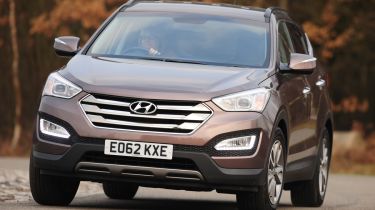Hyundai Santa Fe 2.2 CRDi Premium
The smart and well built Santa Fe is a real step upmarket for Hyundai
Hyundai is no longer a value-for-money brand, and the Santa Fe is an undeniably upmarket product. Build quality and design are first class, while interior space is excellent. Just make sure you don’t need to do any major off-roading.
When the original Hyundai Santa Fe made its debut 12 years ago, it was pitched as a practical SUV that put function over form. But the third generation is now one of the most distinctive 4x4s on the road. The bold grille and LED running lights help it stand out, while the kick-up in the window line gives it a dynamic look.
It’s equally stylish inside, with a smart centre console that’s similar to that in other Hyundais. There are angular air vents and chunky, easy-to-use buttons for the audio and climate controls, while the standard-fit sat-nav is the same system as in the Kia, so the maps are clear and simple. An electric handbrake also means there’s more room for storage on the Hyundai’s centre console.
Passenger space is largely the same as the Sorento’s, too, but the Santa Fe pulls ahead in terms of build quality. It offers a genuine premium feel inside, thanks to the smarter switchgear and decent plastics.
Used - available now

2023 Hyundai
Santa FE
18,730 milesAutomaticPetrol1.6L
Cash £31,649
2023 Hyundai
Santa FE
19,237 milesAutomaticPetrol1.6L
Cash £29,000
2023 Hyundai
Santa FE
15,437 milesAutomaticPetrol1.6L
Cash £33,251
2023 Hyundai
Santa FE
30,009 milesAutomaticPetrol1.6L
Cash £31,490However, while boot capacity is marginally better than the Kia’s, there isn’t quite as much space in the rearmost seats. The tailgate cuts into headroom, plus the tiny side windows make it feel very claustrophobic.
On the road, the Santa Fe delivers similar performance to the Kia, as you would expect given the shared drivetrain. First gear is rather short – to compensate for the lack of a low-range box for off-roading – but the shift is positive, while the rest of the ratios are well chosen to deliver decent in-gear response.
Unlike Kia, Hyundai developed the Santa Fe with specific UK suspension settings, and as a result it feels more composed than the Sorento. Turn-in is sharper, and there’s more grip, but larger 18-inch alloys give the car an unsettled ride at motorway speeds.
Unfortunately, the Hyundai has the least off-road ability here, despite the fact it gets a 4WD lock and hill descent control. The ride height is 10mm lower than the Outlander’s, and a low chin spoiler limits its approach angle, while those lower-profile tyres mean the most challenging terrain the Santa Fe is capable of tackling is a grassy track.
But wherever you go in this car, you’ll be travelling in luxury. As with its rivals, the Hyundai has a raft of standard kit, and while it’s not quite as generously equipped as the Outlander, it has the feeling of an upmarket SUV that the Mitsubishi and Kia are lacking.
But that comes at a price. The 2.2 CRDi Premium model tested here costs £30,670 – nearly £700 more than the Sorento – and some will baulk at paying that for a Hyundai. Still, if you don’t need seven seats, you can save £1,200 by going for the five-seat version.
The rest of the financial case is a mixed bag. You can get fixed-price servicing like the Kia, but it costs £150 more, while its warranty is only five years, albeit with no mileage limit.
So do these financial hurdles stop the Santa Fe taking victory? Or does its upmarket appeal help it to win through?







